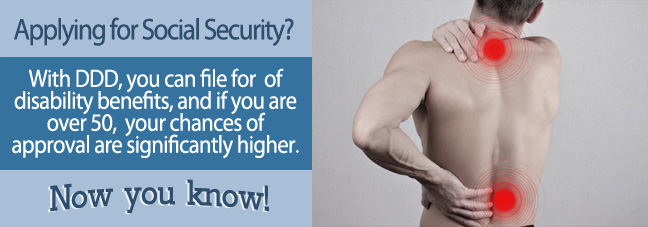Degenerative disc disease is a naturally occurring condition that affects the discs in your spine, usually in your neck and back. It can cause severe neck and back pain and even impact nerve function.
If the symptoms of degenerative disc disease prevent you from doing work you are trained and qualified for, you can apply for Social Security Administration (SSA) disability benefits. Should you also be over 50, the SSA grid rules can improve your chances getting the benefits you need.
If you are over the age of 50 with degenerative disc disease and you think you will be out of work for at least 12 months, get a free case evaluation today.
Further Reading: What Conditions Qualify For Disability?
Is Degenerative Disc Disease a Disability?
Yes, the SSA may consider degenerative disc disease (DDD) a disability severe enough to qualify for disability benefits. There are some quite exacting criteria used by the SSA which it uses to assess eligibility for disability benefits. You must have DDD symptoms that match the description in the relevant section of the Blue Book, have sufficient medical evidence to show that your symptoms are severe and that you cannot work for at least the next 12 months.
If you intend applying through the SSA’s SSDI pathway, you will also need to show that you already have sufficient work credits. The SSI pathway is also an option if you have restricted income and assets.
Further Reading: What Is SSI?
How Hard Is It to Get Disability Benefits For Degenerative Disc Disease?
It’s never easy applying for disability benefits unless your symptoms qualify you for accelerated assessment. Many applications for disability benefits are initially rejected and applicants are then forced to appeal the decision.
The main criteria that help to satisfy the SSA that you are eligible for benefits for your DDD include the following.
- Your DDD symptoms must match the description in the Blue Book listings under Section 1.04: Spine Disorders.
- Have medical evidence documenting the development and severity of your DDD symptoms.
- Failing an exact symptom match, you may need to apply for a medical vocational allowance and obtain a residual functional capacity (RFC) assessment by your doctor.
- Proof that your symptoms are so severe that you are unable to continue working for at least the next 12 months.
- Have enough work credits accumulated to qualify for disability benefits through SSDI.
- Use a disability lawyer for help with your claim.
Grid Rules and Degenerative Disc Disease
The SSA uses its ‘grid rules’ to determine how likely you are to be retrained for different employment that accommodates your disability. The grid consists of the following criteria:
- Your age
- Educational background
- Current job skills
- Whether those skills are transferable
- Your ability to do certain jobs
If you are over 50, your chances of being approved for disability benefits increase, even if the grid does not find you disabled. This is because there are fewer entry level positions offered to older workers and adjusting to a different type of employment after so many years in the same field is more challenging the older you get.

What Type of Work Can Someone Do With This Condition?
Degenerative disc disease can cause both severe and chronic pain that prevents you from holding the same position for long. This means that if your job requires you to sit or stand for extended periods of time, working full-time may become impossible.
If you are over 50 and, for example, employed as a data entry clerk, you may not be able to sit long enough to do effective work. If you apply for disability benefits, you have a better chance of being approved because your age makes it more difficult to transition to a different occupation.
Employers tend to be reluctant to hire older workers for entry-level positions and when you are over 50, retraining can be more challenging. As a result, even if your ‘grid’ does not find you disabled, the SSA could still approve your disability claim.
Qualifying With Degenerative Disc Disease Using The Blue Book
The SSA uses a medical guide, which is called the Blue Book, to determine if an individual meets the medical criteria to qualify for disability benefits with a specific condition. There are many conditions that qualify for disability benefits. Claimants with degenerative disc disease will be considered using Section 1.04 of the Blue Book, which covers spine disorders. To be approved using the listing, degenerative disc disease must lead to a compromised nerve root of the spinal cord or do one of the following:
- Evidence of root compressions that cause spinal pain, limited spinal movement, limited motor function and muscle weakness, and a loss of touch and reflexes OR
- Spinal arachnoiditis – an inflammation of one of the membranes around the nervous system – confirmed by an operative note, pathology report of a tissue biopsy or some other lab tests and it results in the need to readjust positioning or posture every two hours OR
- Lumbar spinal stenosis resulting in pseudoclaudication – when the spaces between the vertebrae narrow – which has been confirmed by medical testing, weakness and chronic pain that results in the inability to move properly.
Medical Evidence To Support Your Disability Claim With Degenerative Disc Disease
If you are applying for SSDI because you are unable to work because of degenerative disc disease, you will need to provide supporting evidence and documentation for your claim. Degenerative disc disease is caused by the grinding on a spinal disc, and it causes sharp pain when you make simple movements.
To have a successful disability benefits claim, you will need to provide supporting documentation for your disability claim. Medical documentation that confirms your diagnosis and that clarifies the severity and the symptoms are a necessity to be approved for disability benefits. You should prepare a detailed list of all your medical providers who have treated your degenerative disc disease so you can get copies of the applicable medical records.
You need to provide records that detail your symptoms, restrictions, and limitations. Be sure to provide a detailed treatment history, results from your last physical exam, documentation by your physician of pain in your arms and legs, details about any mobility issues caused by the degenerative disc disease, notes that detail any signs of radiculopathy, which is tingling and pain when your arms are moved or when you turn your head. Provide documentation that details muscle spasms and severe pain, bowel and bladder control issues, and pain or numbness when you are walking up or down stairs.
The results of a straight leg raise test, details and proof of any medical devices needed to help you walk such as a walker, and any pathology reports are essential. You should also provide copies of any imaging you have done of the spinal column, such as MRI scans, x-rays, and CT scans. Your personal physician knows more about the severity of your condition than anyone else.
If your doctor will fill out a residual functional capacity (RFC) form, it could be very helpful to your claim. The RFC will clearly indicate what you can and cannot do, explaining your restrictions and limitations. As an example, it may say you cannot stand more than an hour at a time and you must rest frequently. Because of mobility issues, you cannot walk more than 1,000 feet and you require a walker to do so may be indicated. You may not be able to bend or left, and you may have difficulty reaching above your head.

Applying For Disability Benefits Over The Age Of 50 With Degenerative Disc Disease
If you are older than 50, your chances of having your claim approved do improve somewhat. At this point, you are older, and you have been established in your career. It wouldn’t be as easy for you to train for a new job or start an entirely different career. Your age and work history are taken into consideration when your disability claim is being approved.
If you are 50, you have earned enough work credits to qualify for Social Security Disability Insurance (SSDI). SSDI requires that you have worked enough and paid in enough Social Security taxes to earn enough credits to be covered. At this point in life, you shouldn’t have a problem with having enough credits if you have worked continuously during the last several years. The older you are, the better your chances of qualifying for disability benefits because you have the additional work credits.
Aging With Degenerative Disc Disease And Other Related Conditions
Degenerative Disc disease (DDD) is complicated because it often comes with other similar conditions. If you have DDD, be aware of the other conditions that you might have concurrently.
What is Cervical Disk Disease?
Degenerative Disc Disease Can affect everyone differently. A common way that someone can experience degenerative disc disease is in the neck. This might be known as Cervical Disc Disease. Cervical degenerative disc disease is commonly a cause of neck pain that can extend into the shoulders and down the arm.
Cervical disc disease is similar to other forms of degenerative disc disease in that it is caused by an aging of the protective flexible discs between the vertebrae in the spine. There is not one cause of degenerative disc disease, however there are a few contributing factors. Genetics often determine how prone one is to cervical disc disease. Injury as well as being overweight can also increase your predisposition to degenerative disc disease.
Almost everyone will experience some sort of degradation of the spine in their lifetime. That is completely normal. However not all experience pain. Degeneration of the spine often won’t become an issue until an individual is above 50. At this point in life, it might be difficult to learn a new skill if you are physically unable which is why it is important to learn more about how the disability application process might change.

Herniated Discs
Both herniated discs and degenerative disc disease are conditions that can make working difficult. Although they affect very similar parts of the body, the conditions themselves are distinct.
Degenerative disc disease is essentially the aging of the flexible shock absorbing discs between the vertebrae. As you age, you lose that flexibility and the space between the vertebrae gets smaller leading to contact between bones or pinched nerves. A herniated disc is a misplacement of the disc entirely. Vertebrae and discs are supposed to be stacked atop one another, however a herniated disc means that there has been some sort of protrusion or bulge from one of your discs. This can put pressure on nerves causing pain and discomfort.
Degenerative disc disease can actually make it easier for herniated discs to occur which is why degenerative disc disease becomes necessary to monitor as one begins to approach or exceed the age of 50. If you have a herniated disc, you should also look for signs of degenerative disc disease. Having both conditions might extend the amount of time that you are expected to be out of work. Be sure to see a doctor and track all relevant diagnosis for your disability benefits claim.
Schmorl’s node
Schmorl’s node is actually a fairly common condition found in those that have some sort of degradation of the spine. Like a herniated disc, Schmorl’s nodes are a protrusion of the disc. However instead of out, the node will protrude up or down into the vertebrae.
For most people, this is a common sign of aging and does not come with any symptoms. However, there are cases when Schmorl’s node can cause pain. If the protrusion reaches up into the bone marrow, this can cause lower back pain.
Although this is not the most debilitating condition that may occur due to degenerative disc disease, it is one more piece of evidence that you can use to demonstrate how your back has aged. An important note about Schmorl’s node is that it is something that is clear on an X-ray. If you are considering an application for disability benefits due to degenerative disc disease. Make sure that you are working with a doctor that can help you to provide evidence that your back is aging. Be sure to look for signs of cervical disc disease, a herniated disc, and Schmorl’s node. As you age, it is possible that you are dealing with multiple conditions all stemming from degenerative disc disease.

Is Retrolisthesis a Disability?
Retrolisthesis is a disabling lower back condition which is caused when spinal vertebrae slip backwards on each other. If left untreated or if degenerative disc disease is involved, the intense pain experienced may make it impossible to continue working. If you suffer from retrolisthesis you may then be able to obtain a disability benefit from the SSA.
The SSA’s Blue Book doesn’t have an actual listing for retrolisthesis, however the symptoms of the condition may be able to be matched with corresponding symptoms listed in the "Musculoskeletal Diseases" section of the Blue Book. Section 1.00 Musculoskeletal Diseases (Adult) lists the symptoms corresponding to medical problems in the spine in addition to other parts of the body’s musculoskeletal system.
Like all SSA disability claims, there must be evidence that the symptoms experienced match one of these descriptions as closely as possible before a claim can be approved.
Evidence of retrolisthesis and/or degenerative disc disease disability must be made available when making a claim using the result of tests, scans, x-rays, medical history and any other documentation from medical professionals that can support the claim.
As one of the main conditions for obtaining a SSD benefit is that the condition is severe enough to make it impossible to work for at least 12 months one other way of proving that your retrolisthesis is a disability is to have residual functional capacity assessment. This can be completed by your physician and tests your capacity to perform a number of physical tasks.
While there is no listing in the SSA's Blue Book for retrolisthesis, you can still qualify for Social Security disability benefits with retrolisthesis if your symptoms and medical evidence can match a listing in the Musculoskeletal diseases listings in the Blue Book, the SSA will consider your retrolisthesis a disability and you will be able to qualify for Social Security disability.
Retrolisthesis is one of many disorders of the spine which commonly makes it far too painful to sit or stand for long periods of time. So if you have to sit or stand while at work you will undoubtedly experience pain. Therefore you may be eligible for Social Security disability benefits if you are unable to work for at least 12 months.
While there is no specific listing for retrolisthesis in the SSA’s Blue Book of disabling conditions, retrolisthesis can cause other impairments of the spine in which, if they meet the SSA’s listing for that condition, then the SSA will consider you disabled and you will be able to qualify for Social Security disability benefits.
If you find section 1.00 in the Blue Book, which covers the Musculoskeletal System (more specifically Musculoskeletal Diseases), you should be able to find symptoms that are the same as yours under disorders of the spine. However, if your diagnosis doesn’t fit exactly anything you find in the Blue Book, you may still be eligible for disability benefits after participating in a Residual Functional Capacity (RFC) assessment.
Your doctor will need to complete an RFC form which will describe the amount and type of work you are able to do when suffering from a degenerative disc disease disability like retrolisthesis. The RFC assesses your ability to sit and stand for prolonged periods, what weights you can lift and what your current mental state is caused by your disability.
Speak With A Disability Attorney
Disability claims are complex. To get your claim on the right track, you should consult with a disability lawyer. When you retain an attorney, you will not have to pay anything out of pocket. Instead, your attorney will not be paid until you win your claim and receive backpay. The SSA guidelines indicate that an attorney will receive 25 percent of your backpay, but the pay is capped at $6,000. You will sign an agreement with the attorney when you hire him.
Claimants who have legal representation are much more likely to be approved for disability benefits. Disability lawyers know how to proceed with the claim and what evidence is needed to show the severity of a medical problem and get your case approved. Your attorney will gather supporting documentation and will review your file to make sure the SSA has access to the records that tell them the severity of your condition and how you are affected.
Lawyers will file any necessary appeals and will also work to prepare you for questioning should your case advance to the hearing level. To make sure you have the help you need to pursue your disability claim, you should complete the Free Case Evaluation Form on this page to share the details of your case with a disability lawyer in your area. You can start your disability claim online at the Social Security website at ssa.gov or by calling 1-800-772-1213 and talking with a representative.
Additional Resources
- What Conditions Qualify For Disability?
- SSDI Application
- SSDI
- SSI
- Disability Lawyer
- Can You Get Disability If You Haven't Worked Enough
- What Common Health Problems Occur For People Over 50?
- Blue Book
- Tips on Qualifying for Degenerative Disc Disease
- How to Apply for Disability Benefits for Degenerative Disc Disease
- How Does Work History Affect Disability Benefits
- How Does The SSA Determine Work?
- How A Physician Can Help With A Disability Claim
- What Forms Should My Doctor Fill Out